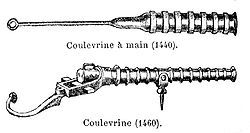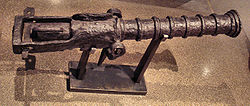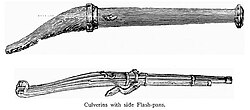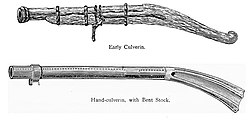Culverin

Aculverinwas initially an ancestor of the hand-heldarquebus,but the term was later used to describe a type ofmedievalandRenaissancecannon.The word is derived from the antiquated "culuering" and theFrench"couleuvrine"(fromcouleuvre"grass snake",followingLatin:colubrinus,lit. 'of the nature of a snake'.)[1]From its origin as a hand-held weapon it was adapted for use asartilleryby the French in the15th centuryand fornavaluse by the English in the16th century.The culverin as an artillery piece had a longsmoothbore gun barrelwith a relatively long range and flattrajectory,using solidround shotprojectiles with highmuzzle velocity.
Hand culverins
[edit]The hand culverin consisted of a simple smoothbore metal tube, closed at one end except for a smalltouch holedesigned to allow ignition of thegunpowder.The tube was attached to a wood or metal extension which could be held under the arm. It was loaded with gunpowder and lead bullets and fired by inserting a burningslow matchinto the touch hole.
James IV of Scotlandwas an enthusiastic user of hand culverins in 1508. He held shooting matches in the great halls ofHolyrood PalaceandStirling Castle,took a culverin to stalk deer in the park ofFalkland Palace,and shot at sea birds from a row boat off theIsle of Maywith his culverin.[2]
In addition to the arquebus, the culverin also evolved into the heavierbreech-loadingswivel gunweighing around 40 kg (88 lb), which required aswivelfor support and aiming. This weapon was designed to use removablemug-shapedchamberswhich were prefilled with gunpowder and projectiles to speed up reloading. Breech-loading swivel guns were often used on ships against enemy crew orboarders.
-
"Handbombard",or early culverin, 1390–1400
-
Hand culverin (middle) with two small cannons, Europe, 16th century
-
Early culverins (15th century): a hand culverin (top), and a culverin with removable chamber (bottom)
-
"Murderer", France, 1410
-
Culverin with side flash-pans
-
Above: Early culverin, below: Hand culverin with bent stock
Field culverins
[edit]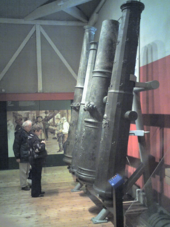
Three types of culverin artillery pieces were used, distinguished by their size: the "culverin extraordinary", the "ordinary", and the "least-sized".[3][4]
| Name | Bore diameter | Length | Weight | Shot diameter | Shot weight |
|---|---|---|---|---|---|
| Culverin extraordinary | 5+1⁄2in (140 mm) | 32 calibers (14 ft 8 in; 4.47 m) | 4,800 lb (2,200 kg) | 5+1⁄4in (130 mm) | 20 lb (9.1 kg) |
| Ordinary culverin | 5+1⁄2in (140 mm) | 25 calibers (12 ft; 3.7 m) | 4,500 lb (2,000 kg) | 5 in (130 mm) | 17 lb 5 oz (7.9 kg) |
| Culverin of the least size | 5 in (130 mm) | 29 calibers (12 ft; 3.7 m) | 4,000 lb (1,800 kg) | 3+3⁄4in (95 mm) | 14 lb 9 oz (6.6 kg) |
There were also smaller versions, including the "bastard culverin" (4 inches; 100 mm), 7-pound (3.2 kg) shot and the "demi-culverin"or" culverin-moyen "(4+1⁄2inches; 110 mm), 10-pound (4.5 kg) shot.[1]
Overall, the culverin was a significant advance over earlier cannons. Since it fired iron round shot instead of stone projectiles and had a longer barrel to enable the gunpowder to fully burn and impart more force to the projectile, the culverin could fire the denser projectile to a relatively greater range and with a flattertrajectory.A replicaculverin extraordinaryhas achieved a muzzle velocity of 408 m/s (1,340 ft/s), and a range over 450 m (1,480 ft) using only minimal elevation.[5]This velocity and mass imply that the cannonball had akinetic energyof roughly 600kilojoules(440,000ft⋅lbf) when leaving the muzzle.
InBritain,Brigadier General Michael Richardswas appointedMaster-General of the Ordnancein 1714 and he commissioned a Danish expert,Albert Borgard,to design a new artillery system. Borgard did away with the traditional nomenclature of culverins,sakersandminions,and devised a new system based on the weight of shot that each gun used, from 4 to 64pounds.Although Borgard's gun designs were quickly superseded, the practice ofnaming ordnance by weight of shotpersisted in Britain into the 20th century.[6]
See also
[edit]- Arquebus
- Demi-culverin
- Doglock
- Flintlock
- Hand cannon
- Matchlock
- Miquelet lock
- Musket
- Pistol
- Snaphance
- Snaplock
- Wheellock
References
[edit]- ^ab"culverin".Oxford English Dictionary(Online ed.).Oxford University Press.(Subscription orparticipating institution membershiprequired.)
- ^James Balfour Paul,Accounts of the Treasurer,vol. 4 (Edinburgh, 1902), pp. lxvii–lxxi, 115, 130.
- ^
 This article incorporates text from a publication now in thepublic domain:Chambers, Ephraim,ed. (1728)."Culverin".Cyclopædia, or an Universal Dictionary of Arts and Sciences(1st ed.). James and John Knapton, et al.
This article incorporates text from a publication now in thepublic domain:Chambers, Ephraim,ed. (1728)."Culverin".Cyclopædia, or an Universal Dictionary of Arts and Sciences(1st ed.). James and John Knapton, et al.
- ^
 This article incorporates text from a publication now in thepublic domain:Chambers, Ephraim,ed. (1728)."Cyclopædia: or, A Universal Dictionary of Arts and Sciences".Cyclopædia, or an Universal Dictionary of Arts and Sciences(1st ed.). James and John Knapton, et al.
This article incorporates text from a publication now in thepublic domain:Chambers, Ephraim,ed. (1728)."Cyclopædia: or, A Universal Dictionary of Arts and Sciences".Cyclopædia, or an Universal Dictionary of Arts and Sciences(1st ed.). James and John Knapton, et al.
- ^Discovery Channel,Battlefield Detectives,episode "Who Sank the Armada"
- ^Collins, A. R."British Cannon Design 1600 - 1800".arc.id.au.Retrieved7 December2021.



